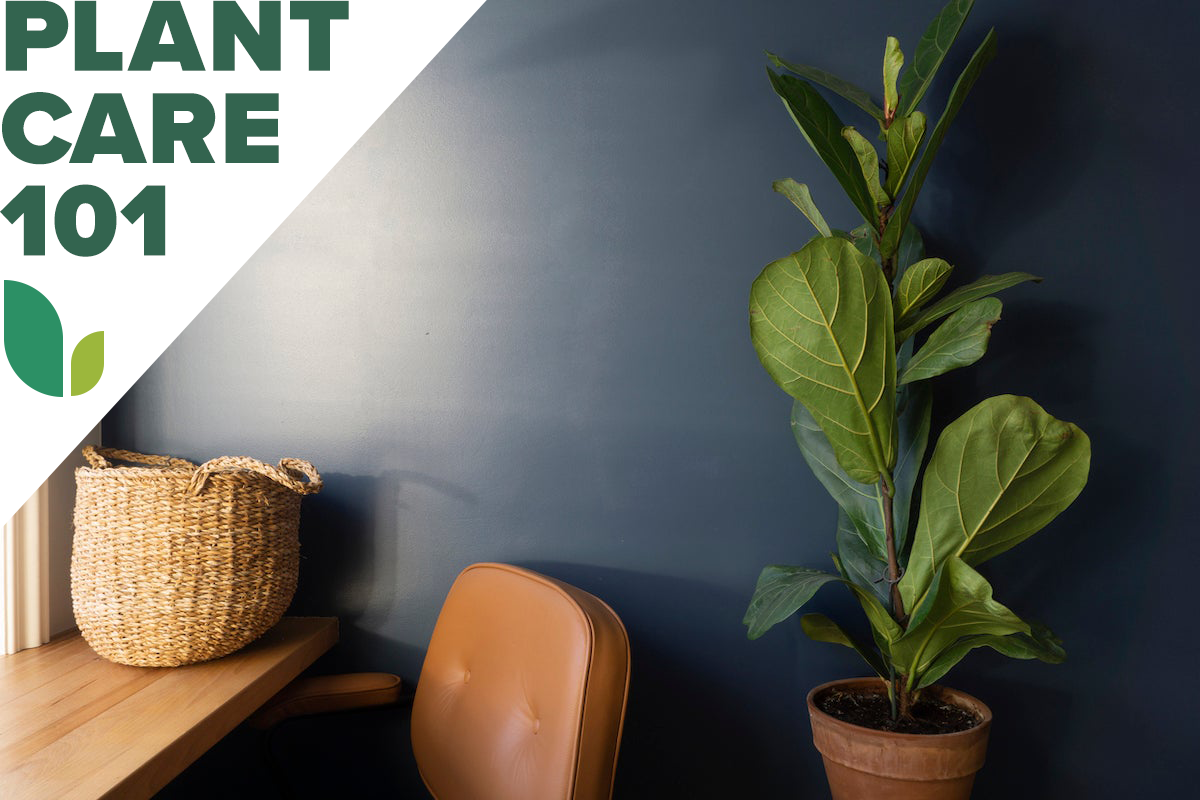

We may earn revenue from the products available on this page and participate in affiliate programs. Learn More ›
The deep green, glossy, dinner-plate-sized leaves of the fiddle leaf fig have made it a popular house plant. Combined with its impressive height—indoors, it can grow to as tall as 10 feet —the African native is sought by many who want to add a touch of the tropics to their decor.
Also known as fiddle fig tree, fiddle leaf tree, and fiddle leaf fig, Ficus lyrata can be a bit tricky to grow, but mindful attention to its needs will reward the caretaker with a lush showstopper.
Fiddle Leaf Fig Care at a Glance
USDA zone: 10-12. Gardeners in some parts of the very southern United States might be able to grow fiddle leaf fig outdoors, but it’s a houseplant in most areas of the U.S.
Soil: fast-draining, pH 6 to 7
Light: bright, indirect light; morning sun is best
Water: Thoroughly when the top 2 inches of soil becomes dry
Food: One tablespoon 3-1-2 liquid fertilizer mixed with a quart of water each time you irrigate, February to September
Temperature and Humidity: Consistent warmth between 65 and 75 degrees Fahrenheit; high humidity between 40 and 60 percent
Propagation: Stem cuttings in soil or water; air layering is an option for larger plants
Safety: Leaves are poisonous to pets and people if ingested
How to Care for a Fiddle Leaf Fig
Originally from Central and West Africa’s tropical regions, where they grow in lowland forests, the fiddle leaf fig plant belongs to the Ficus genus, one of about 850 species in the Moraceae family. As such, they are epiphytes that grow on top of other plants in the wild. Like other plants in the Ficus family, they do not like to be moved, so it’s best to find the right spot in your home and leave them there.
It’s a fast-growing plant with enormous leaves that add drama to any space. The large, glossy leaves are shaped like a violin—thus, the name.
In its natural habitat, where they are pollinated by wasps, the tropical plant produces fruit: small, green figs that nestle under the tough, leathery leaves. However, it’s unusual for them to bloom or fruit in indoor environments. Nevertheless, their popularity resides in their towering form with showstopping foliage, and learning how to care for fiddle leaf fig is key to its success.
Select the Right Soil
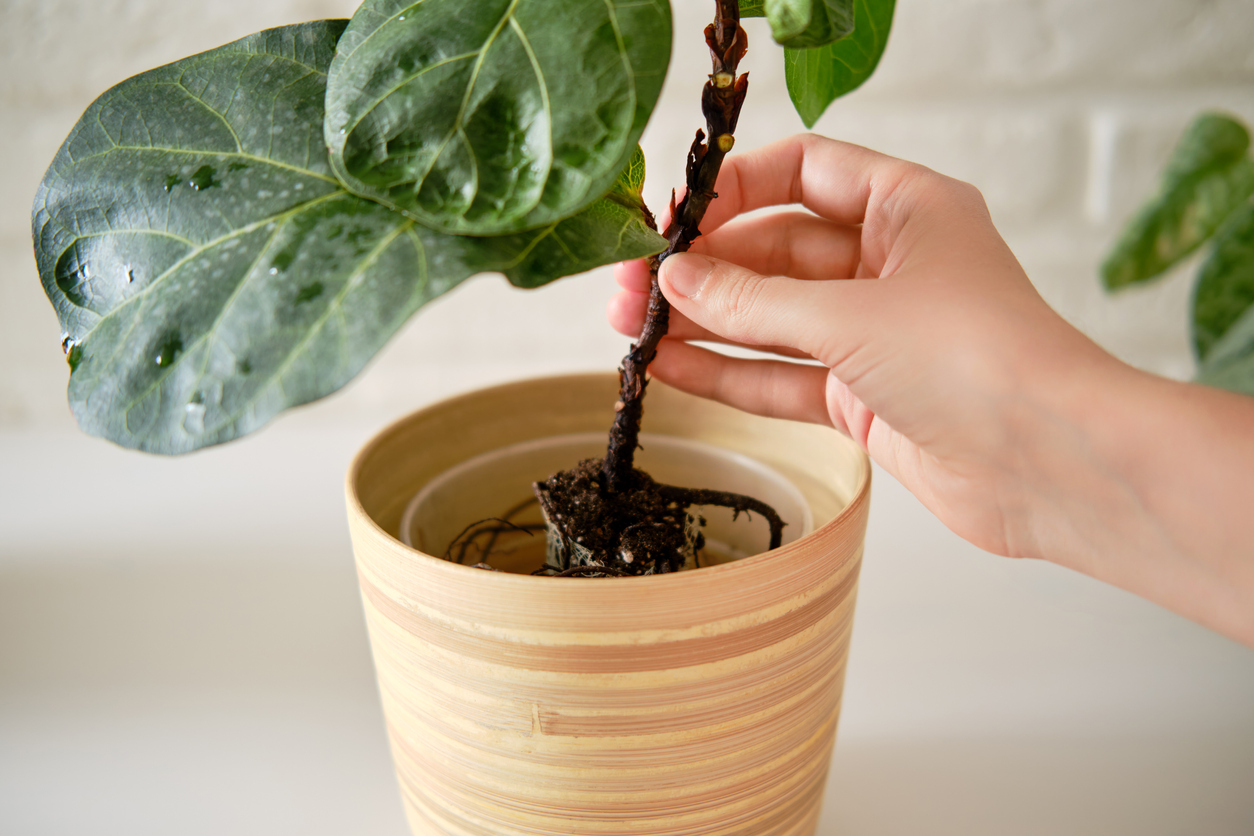
Fiddle leaf fig plants like well-draining soil high in organic matter with a pH between 6 and 7. Look for a soil that provides aeration, good drainage, a bit of grit to prevent clumping, and organic matter. Among the ingredients that address these needs are perlite, vermiculite, peat, coir and sand.
Most quality indoor potting mixes designed for tropical plants will work for fiddle fig trees. Leaves and Soul’s fiddle leaf fig soil, which is our top pick in our researched guide to the best soil for fiddle leaf figs, is formulated specifically for these trees.
RELATED: 11 Things You Didn’t Know That Houseplants Love
Choose the Right Light
Fiddle leaf figs love bright, filtered light, and the more leaves the fig has, the more light it requires. Place the plant in front of a window with eastern exposure to take advantage of soft morning light. If you can’t offer your plant this type of light, you may need to supplement with LED grow lights. Too much direct sun can burn the plants and turn the leaves brown. Rotate the plant every few days to ensure it grows straight, rather than curving toward the light.
Water Your Fiddle Leaf Fig
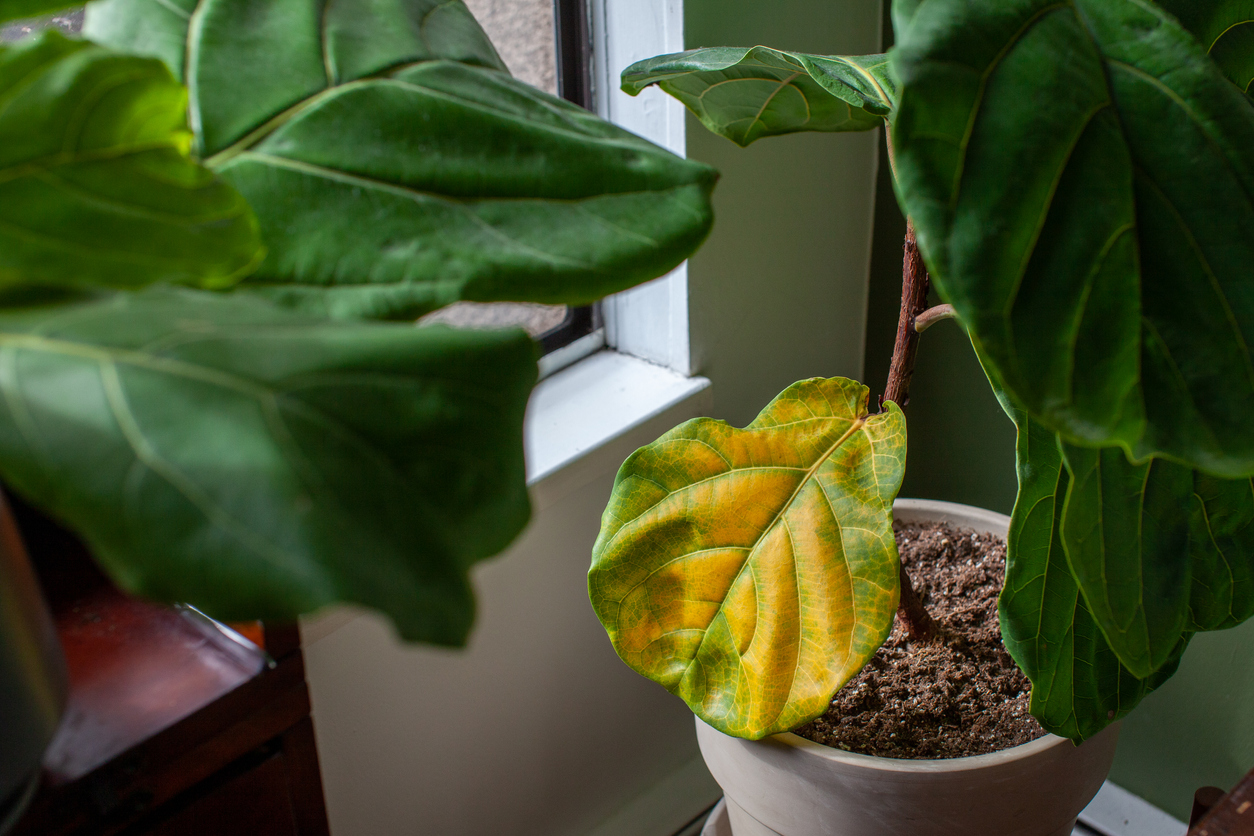
Key to fiddle leaf fig tree care is using room-temperature water to give the plant a thorough soaking. Water that is too hot or too cold can cause the plant to go into shock.
While fiddle leaf fig plants like their soil moist, they don’t like it too wet and can succumb to root rot if overwatered. However, if they don’t get enough water, their leaves will wilt and lose their vibrant green color. Your plant will tell you how often to water fiddle leaf fig.
How often should you water fiddle leaf fig? When the top 2 inches of soil has dried out, it’s time to water again. This typically means about once a week during the active growing season (February–September) and the air is warmer, drying the soil out more quickly. You may need to water only every other week during winter.
Fertilize Your Fiddle Leaf Fig
Fertilize fiddle leaf fig trees throughout the growing season with a high-nitrogen plant food; for example, one that has an NPK ratio of 3-1-2. Fiddle Leaf Fig Plant Food’s urea-free formula is designed specifically for Ficus lyrata. Add a tablespoon of fertilizer to a quart of water and pour into your fig’s soil.
Because they like a neutral pH soil (the perfect level is 6.5), supplements such as coffee—even though it’s high in nitrogen—are too acidic and could be harmful to the plant, causing leaves to turn yellow.
Set the Temperature and Humidity
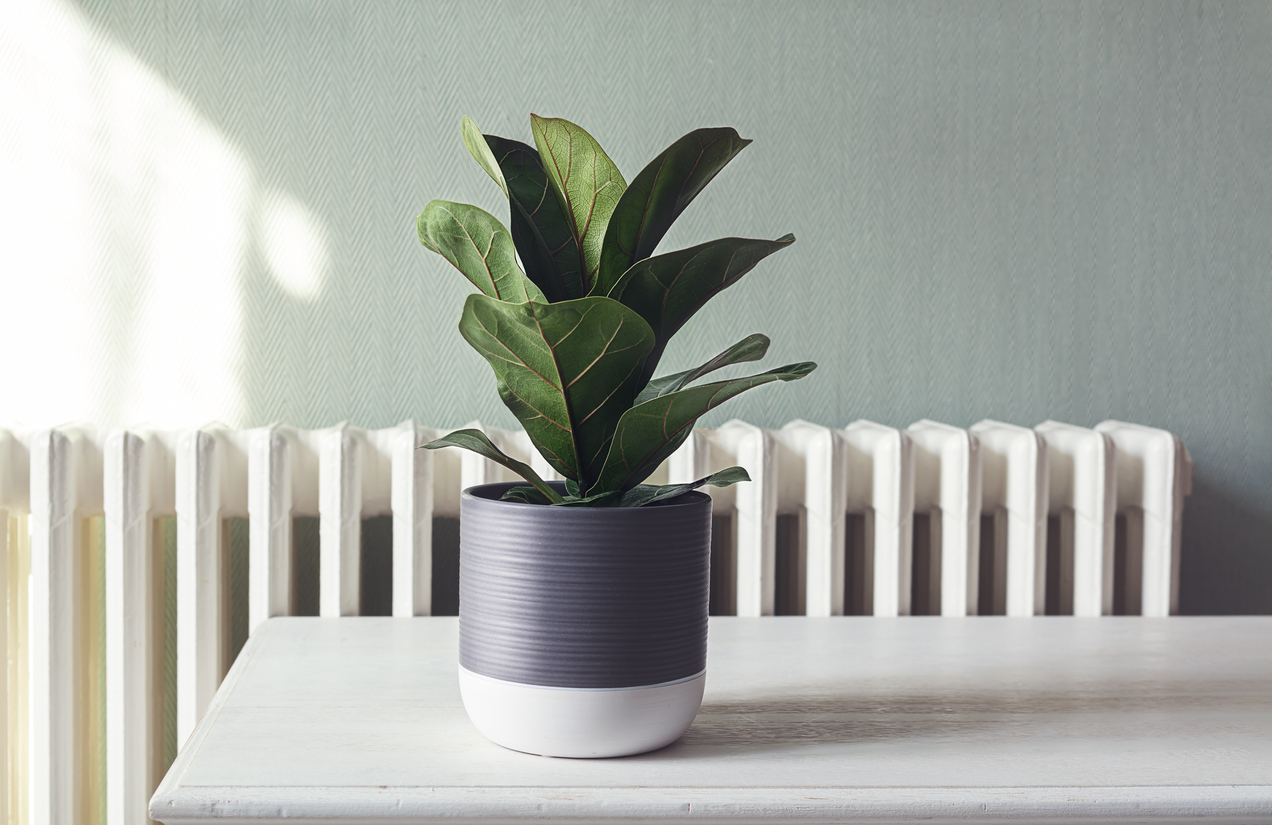
These tropical plants like warm, humid, stable conditions: extreme temperature fluctuations can harm them. Indoors, temperatures between 60 and 75 degrees Fahrenheit are ideal, but avoid placing them near heating and air conditioning vents or drafts, which can cause temperature shifts that result in dry or discolored leaves.
A relative humidity level between 30 and 65 percent provides the best environment for fiddle leaf trees, but because many homes have only 10 percent humidity in the winter, you may want to supplement by placing a humidifier near the plant, misting it, or setting it on a tray of pebbles that is filled with water, as long as the pot isn’t standing in water. Additionally, placing other plants nearby raises the humidity level for all.
RELATED: It’s Not Me, It’s You: The 15 Toughest Houseplants to Keep Alive
Prune Your Fiddle Leaf Fig
In their natural habitat, these trees can grow to 50 feet! If the plant is pushing up against your ceiling, you may be wondering how to prune fiddle leaf fig. You may also want to trim lateral branches if the tree is becoming too bushy or too wide for the space. However you want to prune, do it only during the plant’s active growing season.
Because the sap from this plant is an irritant, it’s a good idea to wear long sleeves and gloves as you set to work. Using sharp, clean pruners, first trim away any dead or dying leaves. Then identify a space between two nodes (the place on a stem from which leaves grow) and make a diagonal cut in the middle between the nodes.
If you need to remove an entire lateral branch, cut just above the branch collar, which is the place where the branch grows from the central trunk. Wipe away the sap with a damp rag.
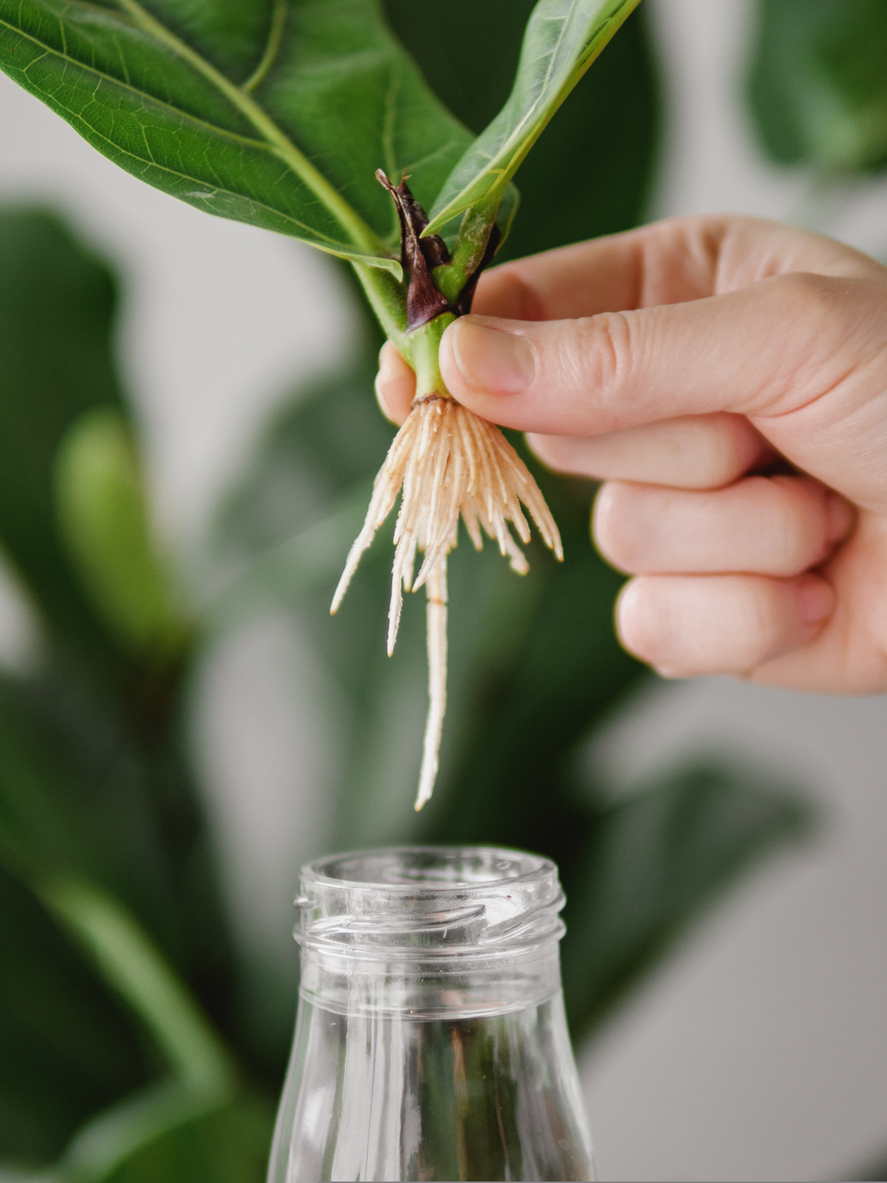
How to Propagate Fiddle Leaf Fig
If you’d like to give a fiddle leaf fig a friend, propagate a second plant. We’ll describe two ways for how to propagate fiddle leaf fig.
- Cut 3 to 4 inches of firm tip growth with at least two leaves; you can also propagate the trimmings from your pruning session.
- Dip the bottom of the stem in rooting hormone.
- Place cutting in a small pot with seed and cutting mix or 50:50 ratio of peat and perlite or propagating sand.
- Look for roots in 6 to 8 weeks.
Alternatively, use the air layering method, which is slower but creates a larger plant.
- Choose a 2- to 3-foot branch that you will eventually cut off.
- Remove two leaves near the branch collar.
- Use a sharp, clean knife to scrape off the bark on the branch near the branch collar.
- Apply rooting hormone to the exposed section of stem; then create a “pocket” around the area with plastic wrap and twist ties.
- Fill the pocket with very wet sphagnum moss and keep it moist for about two months.
- Once roots fill the pocket, use a knife or pruners to separate the new fig plant and transplant it into its own pot.
When to Repot Your Fiddle Leaf Fig
Ficus lyrata can grow a foot or two each year, and can become rootbound quickly. If you find your plant is drying out quickly and needing more frequent than normal waterings, it might be time to repot. Expect to repot it every 2 years, or even annually. Choose a pot that’s about 2 inches in diameter larger than its current home, and do your repotting in springtime for the best results.
RELATED: Count On These 25 Indoor Plants for Easy Color Year-Round
Types of Fiddle Leaf Fig
• Ficus lyrata ‘Bambino’ is a dwarf variety that reaches just 2-3 feet tall while still sporting large, but not as large, leaves. It typically doesn’t grow laterally, so doesn’t require a large space.
• Ficus lyrata ‘Variegata’ is an uncommon, highly sought-after variety with variegated leaves. The dark green centers of the leaves are ringed by a pale yellow, or cream, color.
• Ficus lyrata ‘Compacta’ is a variety that can grow up to 5 feet tall and features smaller, more bunched leaves. It typically grows more slowly than the standard fiddle leaf fig.
Safety Considerations
As with many beautiful plants, the fiddle leaf fig poses a threat in that its leaves are toxic to dogs, cats, and people if ingested. While the plant’s milky sap isn’t fatal, it can cause severe oral burning and irritation, as well as gastrointestinal upset. Pets may drool excessively, vomit, and have difficulty swallowing. The sap can also cause blistering of the skin and dermatitis or skin irritation in children and pets. If you suspect a pet has ingested this plant, call your vet immediately.
Potential Pests and Diseases
Like most houseplants, fiddle leaf fig trees are susceptible to common pests.
- Mealybugs can be picked off by hand or treated with insecticidal soap or neem oil.
- Scale can be removed by gently scraping with a toothbrush or sprayed with insecticidal soap or neem oil.
- Whiteflies can be removed with a small, handheld vacuum. You can also spray with a dish soap solution. Add 1 tablespoon of liquid dish soap to 1 gallon of water and mix well. Pour the solution into a plastic spray bottle and spray it on the infested plant.
- Aphids can be sprayed off with a hose (of course, you’ll want to take your plant outside for this treatment!) or sprayed with a dish soap solution as outlined above.
- Fungus gnats can be combated by applying food-grade diatomaceous earth to the surface of the soil. Avoid overwatering your fig to reduce the chances of attracting this little bug.
RELATED: The 22 Best Trees to Grow Indoors
FAQs
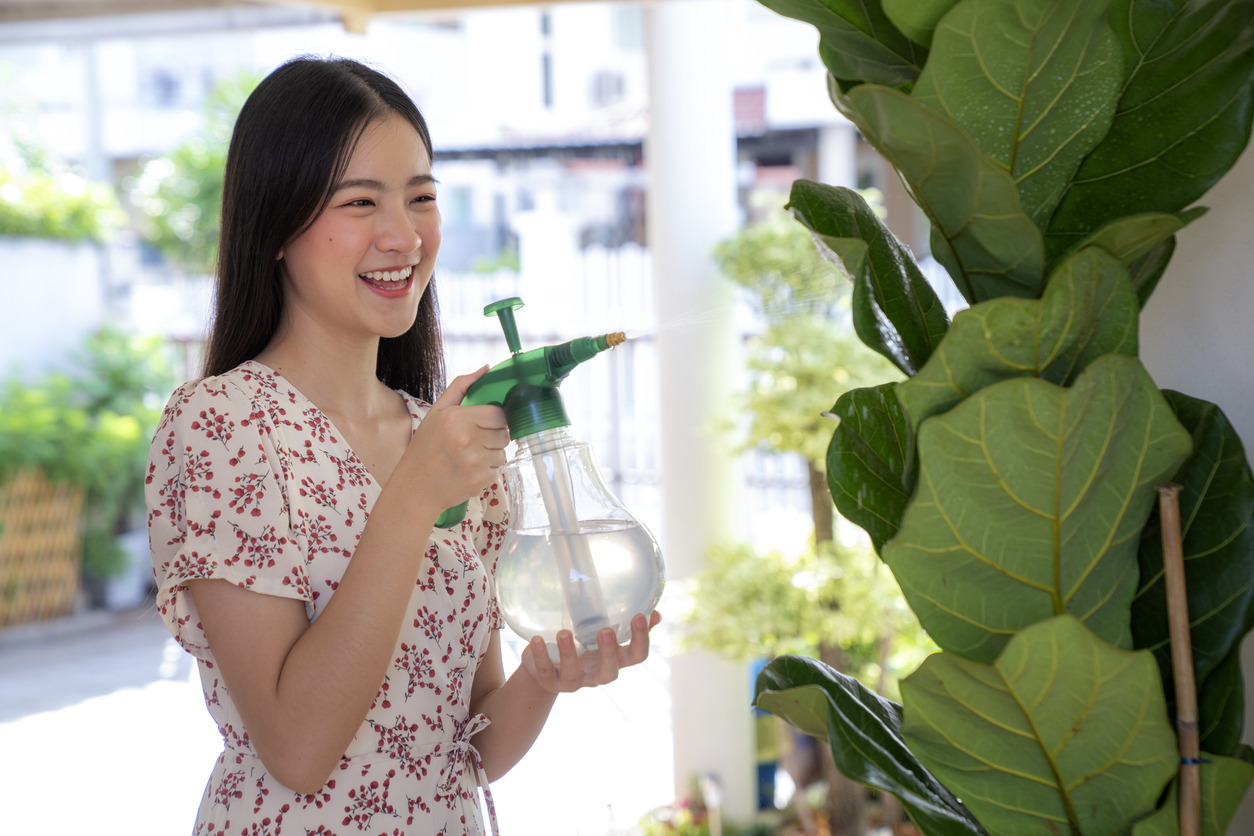
Fiddle leaf fig care isn’t overly demanding, but it is important to do things right in order for them to thrive. With the right care, these majestic plants can live 50 years.
A: Brown spots are probably caused by overwatering. Water only when the top two inches of soil are dry.
A: Yes. According to the ASPCA, fiddle leaf fig leaves are toxic to cats. Contact your vet immediately if you suspect your pet has ingested any part of the plant.
A: Fiddle leaf fig trees can grow 1 to 2 feet per year.
A: Lack of water or a very dry environment can cause a fiddle leaf fig plant to drop its leaves.
A: Simply spray the large leaves with water and wipe them with a soft cloth.
